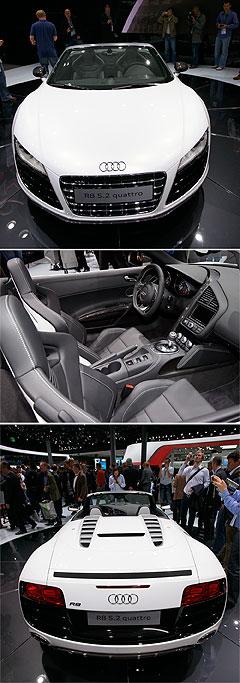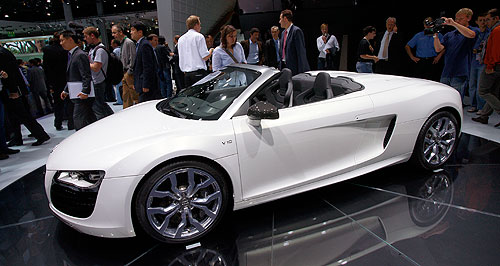Make / Model Search
Future models - Audi - R8 - SpyderAudi R8 Spyder was cocoonedFrom the top down: The Audi R8 Spyder has had a gestation three years longer than its R8 coupe sibling. Audi reveals that topless R8 was hatched years after being designed with coupe7 Dec 2009 By BYRON MATHIOUDAKIS in LOS ANGELES THE designer responsible for the new Audi R8 Spyder, Audi head of exterior design Achim-D Badstübner, has revealed that the coupe and the drop top were drawn up at the same time. This is despite the latter’s delayed unveiling at this year’s Frankfurt motor show – some three years after the production R8 Coupe all but stole the 2006 Paris motor show. “Because of the roof’s mechanism you have to do it simultaneously,” Mr Badstübner told GoAuto at the Los Angeles Auto Show, explaining as an example that the doors of the coupe had been designed to be sufficiently flexible to harmonise with either body style. “We always knew we would come with a Spyder (version of the R8 Coupe) later on. “In the beginning it was clear that we needed a little bit of time between (the variants) first we needed to do the V8, and then the 10 cylinder, and now we’re doing the Spyder. “And of course there is more to come, you know ...  “Because with a car like this you always need to maintain it – you always want some limited editions, just like a Spyder is always the limited edition of a hardtop in volume terms. “A Spyder is always sold more in the California (like) regions … I mean you need a certain climate for the Spyder. The coupe is probably better set for Europe I would think.” Mr Badstübner said Audi tossed up between the fabric roof that won the day and a retractable hardtop design in early planning stages of the car, but in the end aesthetics as much as engineering drawbacks made the decision a no-brainer. “In the very beginning we were thinking about a retractable hardtop or something (similar),” he said. “But that’s just not Audi. All of our convertibles and Spyders have soft tops – so basically we got away from that idea very early in the product phase. “And it’s not just a technical thing (in that) a retractable hardtop’s packaging makes it even higher and also adds more weight. “There are a lot of good reasons against going for a retractable hardtop but it’s also a little bit about the emotion as well. There is more emotion with a soft top, I think. It’s much more pure.” This helped Audi reach its target of containing the Spyder’s extra mass to an extra 100kg overall compared to the coupe. According to Mr Badstübner, the biggest difference between the two body styles (besides the obvious lack of a hard roof on the convertible) is that the top of the rear section of the Spyder has to draw attention to the passengers sitting ahead of it while in the coupe Audi makes a visual statement by exposing the V8 or V12 engine. “We think this concept ... really suits the personality of the car. We did not want to expose the engine so much.” Similarly, the aluminium cowls that extend from the back of the cabin to the rear spoiler are meant to also act as ‘pointers’ to the cabin, while instilling a sense of 1950s Speedster-style racing-car flair. These, Mr Badstübner said, are one of the Spyder’s key stylistic signatures, just as the side blades help to visually define the coupe. Additionally, the cowls serve to be a sort of connection between the headrests, occupants and the rear of a car – like a sort of jet stream effect to emphasise the rapid speed that the car is capable of. This, the designer advises, is best observed from directly above. Doing this, an Audi insider said, is meant to evoke the top half of the female form. On the subject of the interior, Audi had to modify the back-of-seat area for the Spyder, which is used to partly accommodate the folding roof. This proved to be one of the more challenging jobs for the stylists, to maintain the R8 Coupe’s visual harmony and flow. The roof operation switch is in the lower console area between the driver and passenger. “(The button is another example) of something we thought about (for the Spyder) while we were doing the Coupe,” he said, “… the space and where the button is located.” On aerodynamics, Mr Badstübner said the lack of a roof would always make for inferior airflow qualities, but did say that a lot of development work went into the R8 Spyder to eradicate buffeting as much as possible. “But you want to feel a little bit of air (in the cabin) anyway, so there is a balance needed. There was a lot of development work to get an open feel about it while making it a very comfortable car,” he said. “But the downforce and the high speed (control) qualities – of course they are all under control,” he added, saying that going fast on Germany’s autobahns was often the point of such supercar engineering. Achieving perfect proportions, however, was Mr Badstübner’s number one priority. “It is very important that if you have a side view of the car that you get good proportions with either the top on or top off. It’s always extremely important to get this on a Spyder … it shouldn’t sit too high in the back with the roof down. “You need to get a very slim line happening.” Finally, Mr Badstübner said he believed that the Spyder continued the R8 Coupe’s philosophy of being an altogether easier vehicle to live with than the Lamborghini Gallardo that served as a basis for the series. Even the roof system is unrelated between the cars. “The Gallardo Spyder has a completely different roof system,” he said. “It (appeals) to a different customer … it’s a little bit more lifestyle than (the R8 Spyder). “You can daily drive our Spyder – for egress, roof folding … it is just a different sort of car than the Gallardo.” As we reported back in September, the R8 Spyder has debuted with a single engine choice for now – a Lamborghini-sourced 5.2-litre V10 delivering 386kW of power at 8000rpm and 530Nm of torque from 6500rpm. Tipping the scales at 1720kg, it will hit 100km/h from standstill in 4.1 seconds (R8 V10 Coupe: 3.9s), on the way to a top speed of 313km/h – 3km/h shy of the regular version. Australian sales are slated to start in the second half of next year. Along with the R8, Mr Badstübner was also responsible for the current (C6 series) A6, and worked on the entire B8 family of Audis – including the A4, A5 and A5 Convertible.  Read moreAll motor show Alfa Romeo Alfa Romeo Abarth Abarth Alpine Alpine Alpina Alpina Audi Audi Aston Martin Aston Martin BMW BMW Bentley Bentley Chery Chery Brabham Brabham Chrysler Chrysler Chevrolet Chevrolet Cupra Cupra Citroen Citroen DS DS Dodge Dodge Fiat Fiat Ferrari Ferrari Foton Foton Ford Ford Great Wall Great Wall FPV FPV Haval Haval GWM GWM Honda Honda Holden Holden Hummer Hummer HSV HSV Infiniti Infiniti Hyundai Hyundai Jaguar Jaguar Isuzu Isuzu Kia Kia Jeep Jeep Land Rover Land Rover Lamborghini Lamborghini Lexus Lexus LDV LDV Mahindra Mahindra Lotus Lotus Mazda Mazda Maserati Maserati Mercedes-AMG Mercedes-AMG McLaren McLaren MG MG Mercedes-Benz Mercedes-Benz Mitsubishi Mitsubishi Mini Mini Opel Opel Nissan Nissan Peugeot Peugeot Pagani Pagani Proton Proton Porsche Porsche Renault Renault Ram Ram Rover Rover Rolls-Royce Rolls-Royce Skoda Skoda Saab Saab SsangYong SsangYong Smart Smart Suzuki Suzuki Subaru Subaru Toyota Toyota Tesla Tesla Volvo VolvoMotor industry news |
Click to shareAll motor show Alfa Romeo Alfa Romeo Abarth Abarth Alpine Alpine Alpina Alpina Audi Audi Aston Martin Aston Martin BMW BMW Bentley Bentley Chery Chery Brabham Brabham Chrysler Chrysler Chevrolet Chevrolet Cupra Cupra Citroen Citroen DS DS Dodge Dodge Fiat Fiat Ferrari Ferrari Foton Foton Ford Ford Great Wall Great Wall FPV FPV Haval Haval GWM GWM Honda Honda Holden Holden Hummer Hummer HSV HSV Infiniti Infiniti Hyundai Hyundai Jaguar Jaguar Isuzu Isuzu Kia Kia Jeep Jeep Land Rover Land Rover Lamborghini Lamborghini Lexus Lexus LDV LDV Mahindra Mahindra Lotus Lotus Mazda Mazda Maserati Maserati Mercedes-AMG Mercedes-AMG McLaren McLaren MG MG Mercedes-Benz Mercedes-Benz Mitsubishi Mitsubishi Mini Mini Opel Opel Nissan Nissan Peugeot Peugeot Pagani Pagani Proton Proton Porsche Porsche Renault Renault Ram Ram Rover Rover Rolls-Royce Rolls-Royce Skoda Skoda Saab Saab SsangYong SsangYong Smart Smart Suzuki Suzuki Subaru Subaru Toyota Toyota Tesla Tesla Volvo VolvoMotor industry news |










Facebook Twitter Instagram